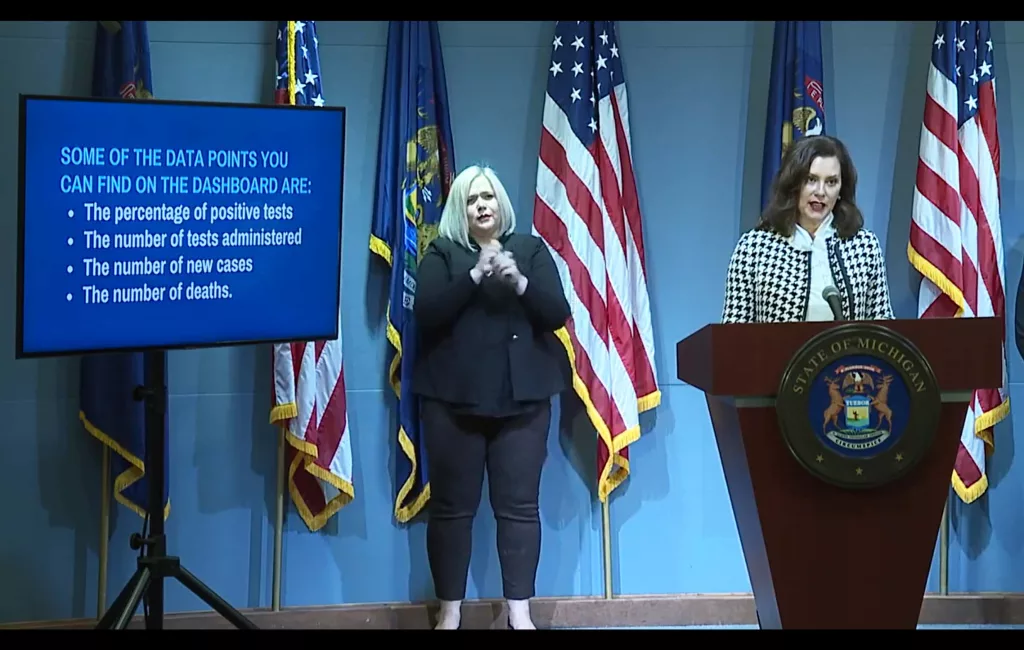Testing and vital information regarding the coronavirus pandemic will both be expanded dramatically following action taken today by Michigan Governor Gretchen Whitmer. First and foremost she has signed Executive Order 2020-104, which expands the types of medical personnel that can order a test, and creates a new category of community testing sites that offer testing to anyone with reason to be tested without an advance order, and without charging an out-of-pocket cost to any Michigander.
Whitmer says, “We need to keep working to expand testing, which is why it is crucial that Michiganders who have COVID-19 symptoms, even mild ones, or have been in contact with someone who has the virus can get tested.” She adds, “This Executive Order will pave the way for more community testing sites to open as we work towards our goal of 15,000 tests administered daily in Michigan. We owe it to the real heroes of this crisis — medical workers, first responders and other essential workers — to do what we can to stop the spread of the virus.”
Under that new Executive Order, anyone who leaves their home for work, or has symptoms of COVID-19 (even mild symptoms), may receive a test at a community testing location without securing a doctor’s order in advance. Medical personnel will be available to order testing upon arrival. A person who wishes to be tested may call the Michigan coronavirus hotline at 1-888-535-6136 or visit this link to find an appropriate testing location: http://www.michigan.gov/coronavirustest
Michiganders eligible for testing include someone who:
- Exhibits any symptom of COVID-19, including mild symptoms
- Has been exposed to a person with COVID-19
- Has been working outside their home for at least 10 days
- Resides in any congregate setting, such as a long-term care facility, prison or jail, homeless shelter, or migrant camp
The order also outlines procedures and protocols testing sites are required to follow.
To view Executive Order 2020-104, click the link below:
EO-2020-104-Emerg-order-testing
Additionally, today, the governor showcased a new online dashboard being launched today that visually illustrates COVID-19 risks and trends in Michigan, providing residents with important information about the pandemic status where they live and work.
Developed through a collaboration between the Michigan departments of Health and Human Services and Labor and Economic Opportunity and the University of Michigan, dashboard data is divided into Michigan Economic Recovery Committee (MERC) regions.
MERC regions were developed by merging Michigan’s Emergency Preparedness Regions and Michigan’s labor sheds – the major areas of the state where people live and travel to work based on U.S. Department of Labor data – so that any outbreak resulting from a return to work could be handled effectively under public health laws.
The governor says, “The most important thing we can do right now is listen to the experts and follow the medical science,” and adds, “Our first responders have put their lives on the line during this crisis, and we owe it to them to get this right. This dashboard will provide us with the data we need to assess risk in different regions of the state so we can re-engage our economy safely and deliberately, while working to minimize the risk of a second wave of infections. The whole goal here is to help ensure we keep more people healthy and out of hospitals.”
The COVID-19 data displayed on the dashboard represents publicly available case, death and test data analyzed to determine overall level of risk and key trends. Graphs, numbers and trends provide a snapshot of how much virus is in a community, and whether it is increasing or decreasing.
Risk levels were developed by MDHHS and the U-M School of Public Health using guidance from the Centers for Disease Control and Prevention, national Guidelines for Opening America and several other leading national organizations.
Dr. Joneigh Khaldun, Chief Medical Executive and Chief Deputy for Health, says, “The risk levels tell us whether there is high, medium or low risk of COVID-19 spread in a community and can help highlight areas where more social distancing may be needed, or where vulnerable individuals should be particularly careful.”
The dashboard, designed and created by faculty at U-M School of Information and School of Public Health, presents risk and capacity indicators that inform implementation of the MI Safe Start Plan. These indicators fall into three categories:
- Epidemic spread
- Health system capacity
- Public health capacity
Each indicator displays a level of risk. These indicators, along with other epidemiologic information, inform the overall risk level for a region. It also incorporates on-the-ground knowledge, such as whether new cases of COVID-19 are localized to a single outbreak or represent communitywide spread.
Sharon Kardia, Ph.D., Associate Dean at U-M School of Public Health, says, “The U-M team is very excited to build this dashboard for the people and State of Michigan,” adding, “This precision public health dashboard is very unique as it clearly shows everyone why some regions can open up more rapidly than others.”
In addition to these risk and capacity indicators, other considerations such as the availability of mitigation measures, the risk posed by certain activities and other economic factors also inform decisions under the MI Safe Start Plan.
To learn more, visit: http://MiStartMap.info






